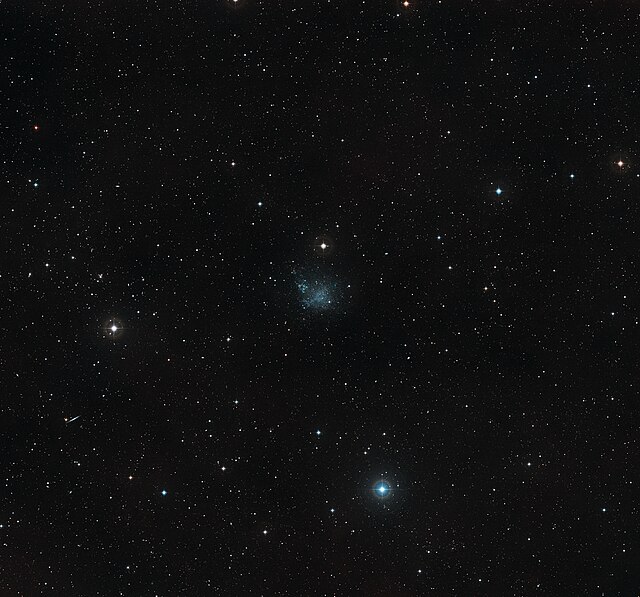IC 1613
Irregular dwarf galaxy in the constellation Cetus From Wikipedia, the free encyclopedia
IC 1613 (object 1613 in the Index Catalogues (IC), also known as Caldwell 51) is an irregular dwarf galaxy, visible in the constellation Cetus near the star 26 Ceti.[6] It was discovered in 1906 by Max Wolf,[7] and is approaching Earth at 234 km/s.
| IC 1613 | |
|---|---|
 | |
| Observation data (J2000 epoch) | |
| Constellation | Cetus |
| Right ascension | 01h 04m 47.8s[2] |
| Declination | +02° 07′ 04″[2] |
| Redshift | −234±1 km/s[2] |
| Distance | 2.38±0.07 Mly (730±20 kpc)[3][4] |
| Group or cluster | Local Group |
| Apparent magnitude (V) | 9.9[2] |
| Absolute magnitude (V) | −15.2[5] |
| Characteristics | |
| Type | IB(s)m[2] |
| Mass | (1.1±0.2)×108[5] M☉ |
| Apparent size (V) | 16.2′ × 14.5′[2] |
| Other designations | |
| UGC 668,[2] DDO 8,[2] PGC 3844,[2] Caldwell 51 | |

IC 1613 is a member of the Local Group.[8] It has played an important role in the calibration of the Cepheid variable period-luminosity relation for estimating distances.[9] Other than the Magellanic Clouds, it is one of the few Local Group dwarf irregular galaxy where RR Lyrae-type variables have been observed; this factor, along with an unusually low abundance of interstellar dust both within IC 1613 and along the line of sight enable especially accurate distance estimates.[8][10]
In 1999, Cole et al.[8] used the Hubble Space Telescope to find that the dominant population of this galaxy has an age of ~7 Gyr. Using its Hess diagram, they found that its evolutionary history may be similar to that of the Pegasus Dwarf Irregular Galaxy. Both galaxies are classified as Ir V in the DDO system. Also in 1999, Antonello et al. found five cepheids of Population II in IC 1613, giving self-evident support for the existence of a very old stellar population component of IC 1613. In 1999, King, Modjaz, & Li discovered the first nova ever detected in IC 1613.[11]

IC 1613 contains a WO star known as DR1, which might be the only Wolf–Rayet star in the galaxy,[12][13] although a candidate WC+O binary, SPIRITS14bqe, has been found.[14] A luminous blue variable candidate[15] has been proposed but a revised classification led to a B2.5 III type.[16] Moreover, a rich population of OB-type[16] stars and OB associations[17] has been discovered.
There are many faint galaxies close to IC 1613, 14 of which are catalogued as members of a yet-unnamed galaxy cluster located at z≈0.20.[18]
References
External links
Wikiwand - on
Seamless Wikipedia browsing. On steroids.
